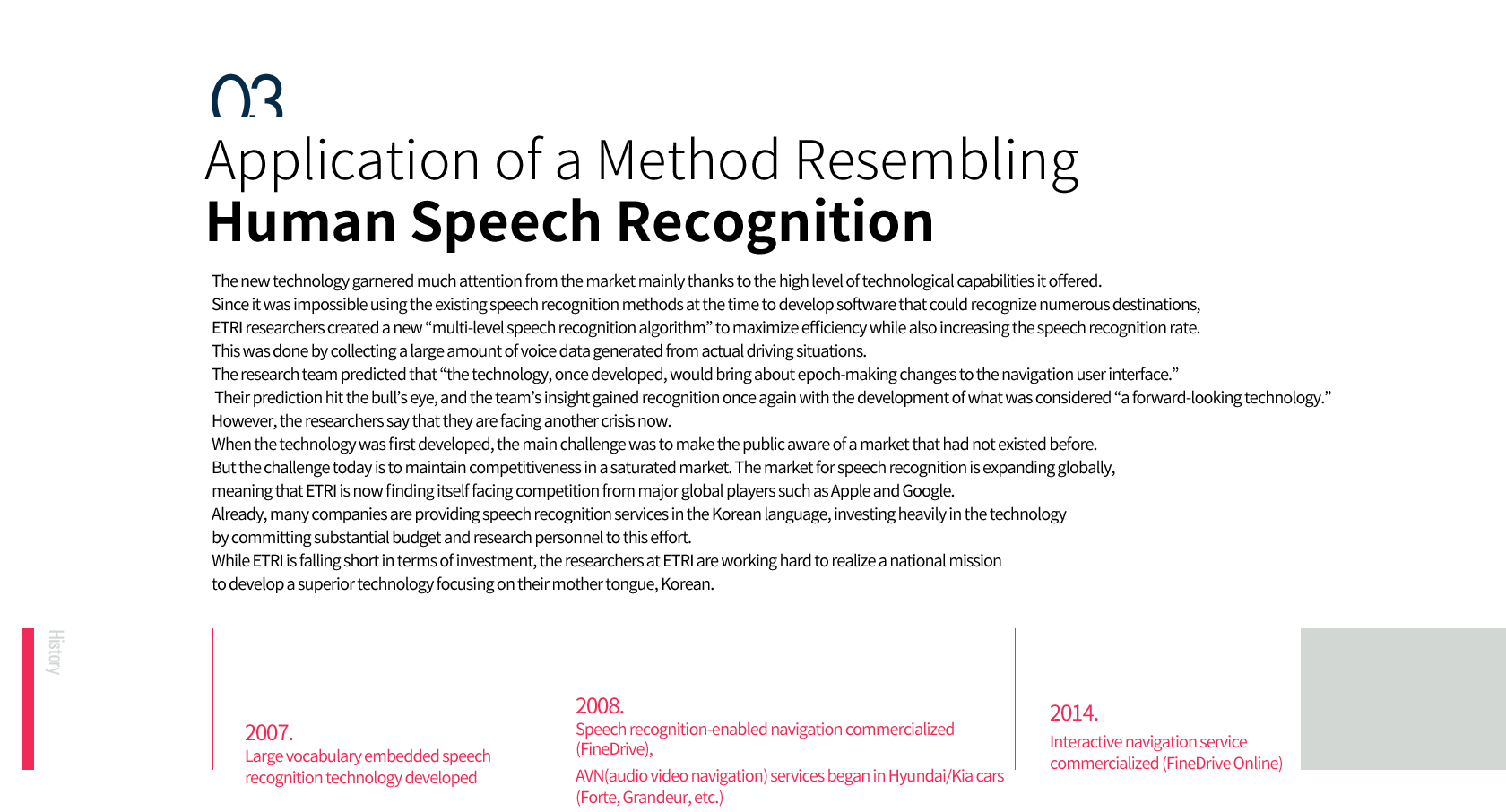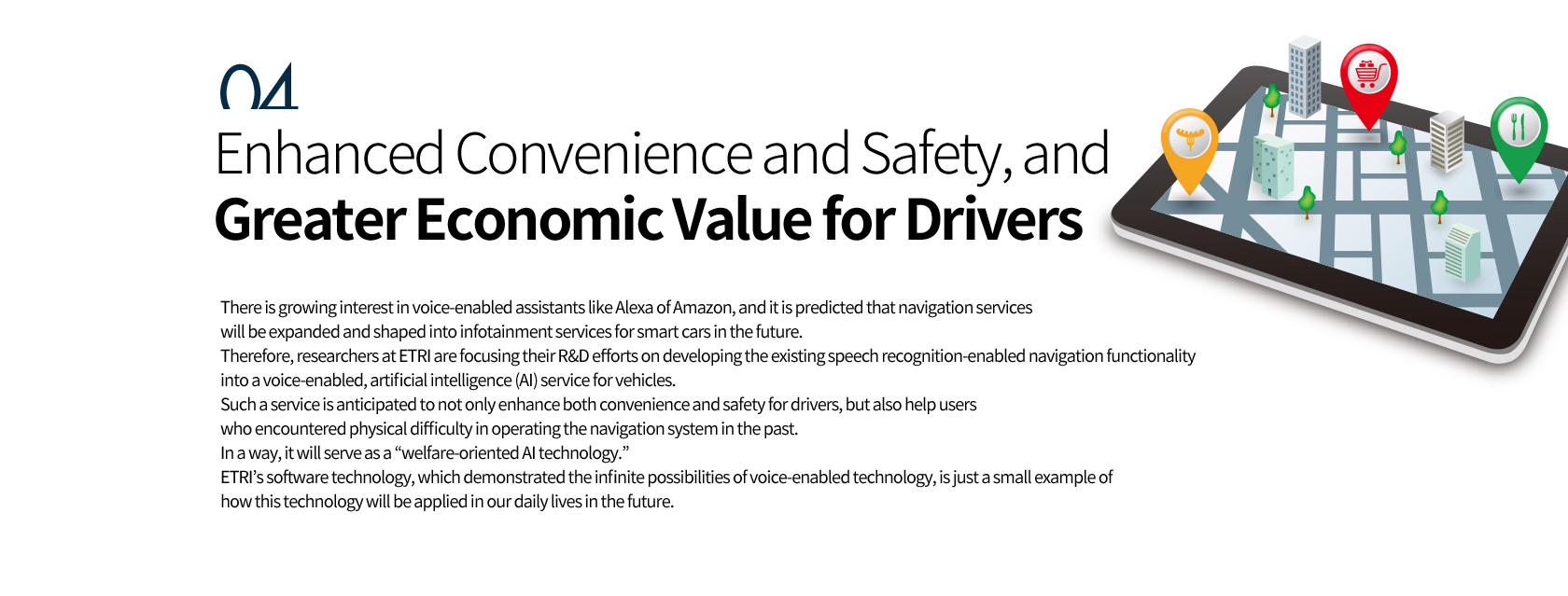





Get Directions by 'Asking'
'Speech-Enabled Navigation System'
Will Answer Your Question

The GPS navigation market expanded little by little from the 2000s, and started growing in earnest from 2006. As motorists increased, so did the number of people using GPS navigation systems. It is undeniable that advances in IT technology contributed to this growth as well. More recently, navigation systems equipped with speech recognition functionality are being introduced, further enriching the lives of navigation users. The “Speech recognition-enabled navigation” developed by ETRI is at the pinnacle of this speech recognition technology. It is a reliable guide that shows you the fastest yet most accurate route to your destination at your verbal command, and keeps you safer while on the road.

01
An Increasing Number of Navigation Users
Find Directions with Verbal Commands
It is safe to say that the GPS navigation market has reached a saturation point. After sharp growth in the 2000s, navigation has become such an essential item for drivers that it has left little room for the market to grow. Some say that the navigation market is declining, but considering the growth in the smart car market and the increasing demands for infotainment for vehicles, including navigation functionality, it can be stated that the number of users for programs that let them find directions while driving is continuously increasing. In other words, what we need now is a new type of navigation software. Realizing this market trend early on, ETRI hurried to develop a navigation system based on speech recognition. ETRI, which had already made a “speech recognition-enabled navigation system” public in 2007, announced that a speech-enabled navigation system would let users reach their destination simply by “saying” where they wanted to go, without having to type anything on the keypad. This opened up a new market in which speech recognition technology was applied to existing navigation technology. Mainly because having to press the keypad on the navigation system while driving is not only quite inconvenient but can also cause serious safety issues, people started showing interest in ETRI’s software, which is equipped with the world’s leading “embedded speech recognition technology” that can recognize up to 450,000 words.

02
Can We Simply 'Ask' for Directions
Instead of Pressing the Keypad?
This technology was born from a rather simple yet hard-to-answer question. While the existing navigation systems were convenient, they invariably involved safety issues because users had to physically type in their destinations using the keypad. If the destination changed while driving, typing the new destination into the navigation system using your fingers interfered with keeping your eyes forward and could cause accidents on the road.
Researchers at ETRI thought hard about effective ways for people to nurture safer driving habits and developed a new concept navigation system utilizing the speech recognition technology that they had studied in the past. The name “speech recognition-enabled navigation” explains it all. The software, developed in 2007, was designed to be embedded in PDAs or navigation devices. To allow fast recognition of a rich vocabulary comprising tens of thousands of POIs(point-of-interists), rather than the existing speech recognition technology, the ETRI team decided to apply a process similar to human speech recognition; this new approach was evaluated and found to offer greater efficiency. The history of speech recognition-enabled navigation began in 2006 with research in industrial fields to find new growth engines. At the time, telematics, robotics, and home automation, among other subjects, were mentioned as new growth engine technologies that would enhance Korea’s national competitiveness. ETRI, while continuing its research efforts on the aforementioned technologies, started looking for ways to apply speech recognition to navigation systems as well. In essence, “speech recognition-enabled navigation” refers to the functionality of a GPS device to recognize a destination verbally spoken to it and to suggest directions to get to that destination. Until then, the world had yet to see a technology to effectively embed a navigation terminal (device) with the capability to recognize tens of thousands to millions of spoken destinations. The research team member at ETRI recalls the sense of crisis and uncertainty that they felt when they were not sure if this unprecedented technology could be successfully commercialized. Thankfully, ETRI teamed up with a navigation specialist in Korea and succeeded in the technology’s commercialization. The technology was adopted by a major Korean carmaker, and the market started to expand with this adoption. The smartphone market’s growth contributed to the technology’s vigorous adoption as well.

03
Application of a Method Resembling
Human Speech Recognition
The new technology garnered much attention from the market mainly thanks to the high level of technological capabilities it offered. Since it was impossible using the existing speech recognition methods at the time to develop software that could recognize numerous destinations, ETRI researchers created a new “multi-level speech recognition algorithm” to maximize efficiency while also increasing the speech recognition rate. This was done by collecting a large amount of voice data generated from actual driving situations. The research team predicted that “the technology, once developed, would bring about epoch-making changes to the navigation user interface.” Their prediction hit the bull’s eye, and the team’s insight gained recognition once again with the development of what was considered “a forward-looking technology.” However, the researchers say that they are facing another crisis now. When the technology was first developed, the main challenge was to make the public aware of a market that had not existed before. But the challenge today is to maintain competitiveness in a saturated market. The market for speech recognition is expanding globally, meaning that ETRI is now finding itself facing competition from major global players such as Apple and Google. Already, many companies are providing speech recognition services in the Korean language, investing heavily in the technology by committing substantial budget and research personnel to this effort. While ETRI is falling short in terms of investment, the researchers at ETRI are working hard to realize a national mission to develop a superior technology focusing on their mother tongue, Korean.

04
Enhanced Convenience and Safety,
and Greater Economic Value for Drivers
There is growing interest in voice-enabled assistants like Alexa of Amazon, and it is predicted that navigation services will be expanded and shaped into infotainment services for smart cars in the future. Therefore, researchers at ETRI are focusing their R&D efforts on developing the existing speech recognition-enabled navigation functionality into a voice-enabled, artificial intelligence (AI) service for vehicles. Such a service is anticipated to not only enhance both convenience and safety for drivers, but also help users who encountered physical difficulty in operating the navigation system in the past. In a way, it will serve as a “welfare-oriented AI technology.” ETRI’s software technology, which demonstrated the infinite possibilities of voice-enabled technology, is just a small example of how this technology will be applied in our daily lives in the future.
- 2007.
- Large vocabulary embedded speech recognition technology developed
- 2008.
- Speech recognition-enabled navigation commercialized (FineDrive),
AVN(audio video navigation) services began in Hyundai/Kia cars (Forte, Grandeur, etc.) - 2014.
- Interactive navigation service commercialized (FineDrive Online)


